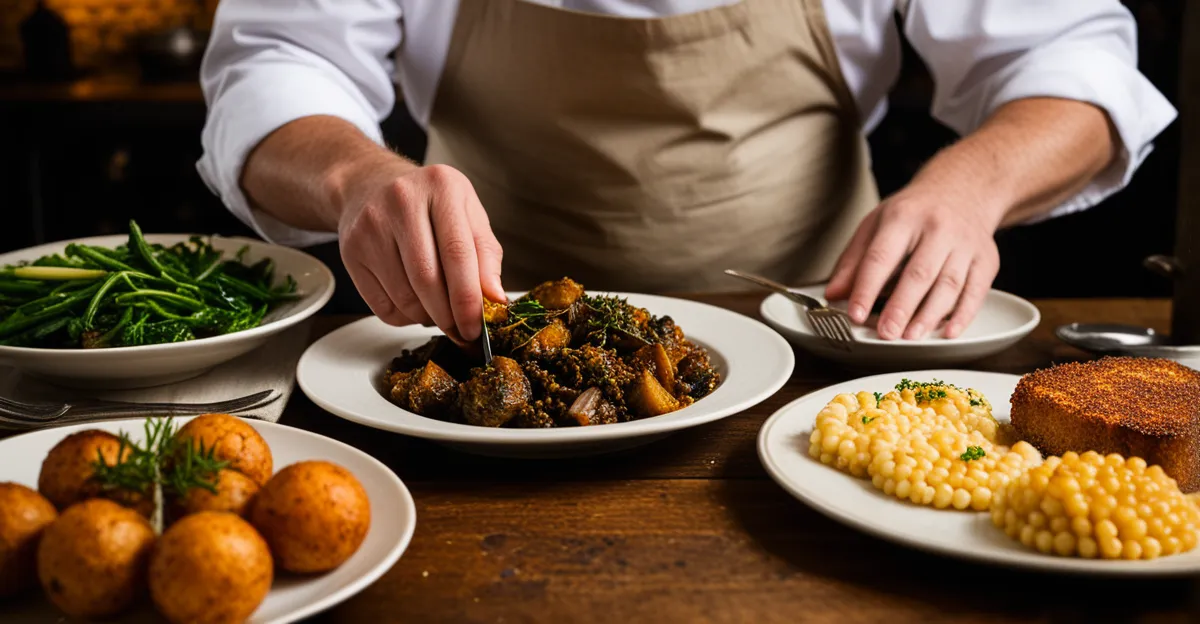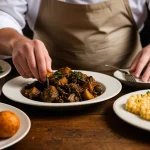Core Characteristics of Traditional UK Cooking
Traditional UK cooking centers around simplicity and richness, with a strong focus on British culinary staples such as beef, lamb, and pork. These meats form the backbone of many classic dishes, prized for their ability to deliver hearty flavors suitable for the UK’s often cool climate. Root vegetables, including potatoes, carrots, and parsnips, complement these meats and add essential nutrition. These essential British ingredients are usually cooked in ways that emphasize their natural flavors and textures.
Seasonality and accessibility drive the selection of ingredients in traditional UK cooking, where the goal is comfort and sustenance. Meals are typically designed to feed families, highlighting a communal dining experience. This results in the creation of dishes that are warming and fulfilling, combining protein and vegetables in balanced but simple presentations.
Also to see : How Can You Explore Traditional UK Flavors Through Food Tours?
The emphasis on comfort food conveys not only nutrition but also a sense of home and tradition. This means dishes often feature slow-cooked meats and roasted vegetables, showcasing the straightforward yet satisfying nature of British culinary staples. The signature of traditional UK cooking lies in its ability to transform humble ingredients into memorable and nourishing meals.
Classic Cooking Methods in British Cuisine
British cooking techniques emphasize roasting and baking as fundamental methods in preparing traditional British recipes. Roasting meats like beef and lamb enhances their natural flavors and produces the signature crispy exterior prized in many classic dishes. Baking is equally prevalent, particularly for pies and pastries that showcase essential British ingredients with a comforting texture.
Also read : How can you master the art of making a hearty steak and ale pie?
Stewing and boiling are crucial for developing deep, rich flavors, especially in hearty dishes where tougher cuts of meat require longer cooking times. These methods tenderize ingredients like pork and root vegetables, enabling flavors to meld and intensify. Stews and broths exemplify how traditional UK cooking balances simplicity with depth.
Differences between rural and urban UK food preparation reflect ingredient availability and lifestyle. Rural cooking often relies more on locally sourced, seasonal produce and meats, maintaining strong ties with British culinary staples. Urban kitchens may incorporate faster techniques or diverse influences but still honor traditional British cooking techniques by adapting them to modern needs. This blend highlights how UK food preparation evolves while rooted in history.
Signature Dishes and Flavors
Traditional UK cooking shines through its British signature dishes that reflect comfort and hearty nourishment. Popular meals like the classic roast dinner combine British culinary staples such as beef or lamb with essential British ingredients like potatoes and carrots. This dish, central to family-style dining, showcases the art of slow roasting to develop rich flavors and tender textures.
Pies represent another iconic element of UK cuisine, often filled with pork or beef alongside root vegetables. Their flaky pastry crust and savory contents embody the balance of simple, satisfying components. Fish and chips hold a special place, featuring battered fish fried to crisp perfection, commonly enjoyed with malt vinegar, an essential condiment enhancing the dish’s flavor.
The UK flavours typical in these dishes favor mild spices and fresh herbs, creating comforting, familiar tastes. Gravies prepared from meat drippings or stocks add depth without overwhelming the palate. Mint sauce frequently accompanies lamb, while malt vinegar complements fried foods, illustrating how condiments shape the traditional British food experience. These signature dishes emphasize simplicity, warmth, and familiarity, upholding the enduring appeal of traditional UK cooking.
Regional Specialties Across the UK
Regional specialties showcase the rich British food regionalism found throughout the UK’s diverse landscape. Each area draws on local resources and traditions to create unique dishes that reflect its history and environment. England offers notable items like the Yorkshire pudding, a savory baked batter that perfectly complements roast beef, and Cornish pasties, hearty pastries filled with beef and vegetables, originally designed as portable miners’ meals.
Moving to Wales, Welsh rarebit stands out with its melted cheese sauce seasoned with mustard and ale, served hot on toasted bread—an excellent example of using simple, essential British ingredients in a distinctive way. Scotland is famous for its iconic haggis, a robust pudding of sheep’s offal, oatmeal, and spices, symbolizing Scotland’s rural culinary identity. Northern Ireland offers its own delicious specialties, such as the Ulster fry, a breakfast plate featuring sausages, eggs, and soda bread.
These UK regional delicacies highlight how local geography and available ingredients shape traditional local cuisine. They underline the importance of seasonal and British culinary staples in crafting authentic regional dishes that connect the food culture directly to place.
Historical Influences on UK Culinary Traditions
The history of British cuisine reveals a dynamic journey shaped by centuries of cultural exchange and exploration. The UK culinary evolution is deeply tied to its imperial history, where global trade introduced new spices like cinnamon, nutmeg, and pepper, gradually transforming the flavours of traditional dishes. This evolution infused British food heritage with diversity while maintaining its core identity.
For example, the introduction of spices during the colonial era enriched familiar meat-based recipes, adding warmth and complexity without overpowering the original ingredients. This integration of foreign elements demonstrates how traditional UK cooking adapted creatively, balancing innovation with respect for established tastes.
Over time, classic recipes have undergone subtle modifications—steeping in new influences while preserving their essence. The movement of people also brought culinary techniques and ingredients that shaped regional specialties and urban cooking styles alike, emphasizing how the UK’s culinary history is a tapestry woven from both domestic traditions and international connections.
This historical layering underlines the resilience and flexibility of British food culture, allowing traditional dishes to remain relevant and cherished across generations.










